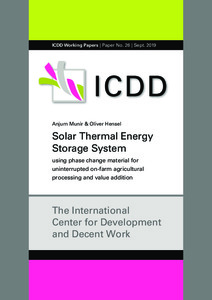| dc.date.accessioned | 2020-08-11T13:44:15Z | |
| dc.date.available | 2020-08-11T13:44:15Z | |
| dc.date.issued | 2019 | |
| dc.identifier | doi:10.17170/kobra-202008051532 | |
| dc.identifier.isbn | 978-3-7376-0635-6 (e-bbok) | |
| dc.identifier.uri | http://hdl.handle.net/123456789/11679 | |
| dc.language.iso | eng | eng |
| dc.publisher | kassel university press | |
| dc.relation.uri | urn:nbn:de:0002-406353 | |
| dc.rights | Namensnennung - Weitergabe unter gleichen Bedingungen 4.0 International | * |
| dc.rights.uri | http://creativecommons.org/licenses/by-sa/4.0/ | * |
| dc.subject | latent heat storage | eng |
| dc.subject | Mannitol | eng |
| dc.subject | computational fluid dynamics | eng |
| dc.subject | Scheffler reflector | eng |
| dc.subject | solar heat receiver | eng |
| dc.subject.ddc | 620 | |
| dc.title | Solar Thermal Energy Storage System | eng |
| dc.type | Working paper | |
| dcterms.abstract | Thermal energy storage technologies are gaining attention nowadays for uninterrupted supply of solar power in off-sunshine hours. An indigenized solar phase change material (PCM) system was developed and performance evaluated in the current study to efficiently store solar thermal power using a latent heat storage approach, which can be utilized in any subsequent decentralized food processing application. A 2.5 m2 laying Scheffler reflector is used to precisely focus the incoming direct normal irradiance (DNI) on a casted aluminum heat receiver (220 mm diameter) from where this concentrated heat energy is absorbed and conducted to the PCM unit by the flow of thermal oil (Fragoltherm-32 thermo-oil). During the circulation around PCM pipes inside the PCM unit, thermal oil discharges heat energy to the PCM, which undergoes change of phase from solid to liquid. Computational fluid dynamics (CFD) analysis of the PCM unit were also performed according to the actual boundary conditions, which gave satisfactory results in terms of temperature and velocity distribution. With an average DNI of 781 W/m2, the highest temperature of the receiver surface during the trials was observed at about 155 C that produces thermal oil at 110°C inside the receiver and around 48°C of PCM in the PCM unit. The heat energy losses per unit time (W) due to the lack of reflectivity from the Scheffler reflector, out-of-focus radiations at the targeted area, absorptivity of heat receiver, piping system losses, and cylinder losses (in the form of conduction, convection, and radiations using 50 mm insulation thickness) were found to be 110 W (10 %), 99 W (9 %), 89 W (8 %), 128 W (12 %), 161 W (15 %), and 89 W (8 %), respectively. These findings of CFD analysis and mathematical modeling were also consistent with real-time data, which was logged through an online Control and Monitoring Interface portal. The final energy available to the PCM was 414W with an overall system efficiency of 38 %, which can be improved by decreasing thermal losses of the system and using other PCM materials. | eng |
| dcterms.accessRights | open access | |
| dcterms.creator | Munir, Anjum | |
| dcterms.creator | Hensel, Oliver | |
| dcterms.extent | 45 Seiten | |
| dcterms.isPartOf | ICDD Working Papers ;; No. 26 | |
| dc.publisher.place | Kassel | |
| dc.relation.isbn | 978-3-7376-0634-9 (print) | |
| dc.subject.swd | Sonnenenergie | ger |
| dc.subject.swd | Latentwärmespeicher | ger |
| dc.subject.swd | Mannit | ger |
| dc.subject.swd | Reflektor <Lichttechnik> | ger |
| dc.subject.swd | Sonnenkollektor | ger |
| dc.title.subtitle | using phase change material for uninterrupted on-farm agricultural processing and value addition | eng |
| dc.type.version | publishedVersion | |
| dcterms.source.series | ICDD Working Papers | |
| dcterms.source.volume | No. 26 | |
| kup.iskup | true | |
| kup.series | ICDD Working Papers | |
| kup.subject | Naturwissenschaft, Technik, Informatik, Medizin | |
| kup.typ | Monographie | |
| kup.institution | FB 11 / Ökologische Agrarwissenschaften | |
| kup.institution | FB 14 / Bauingenieur- und Umweltingenieurwesen | |



